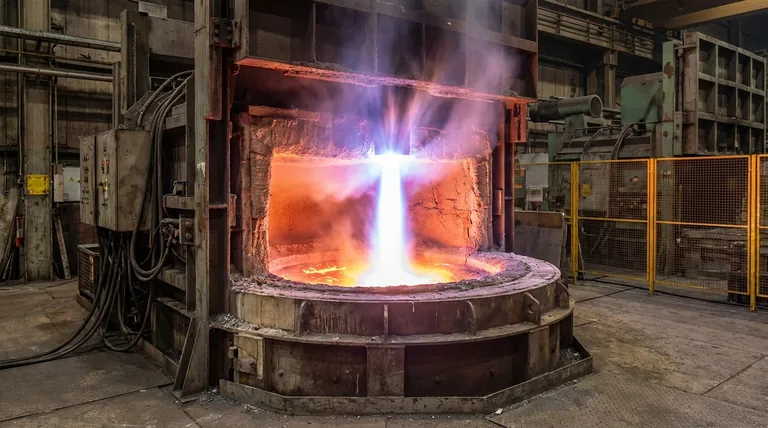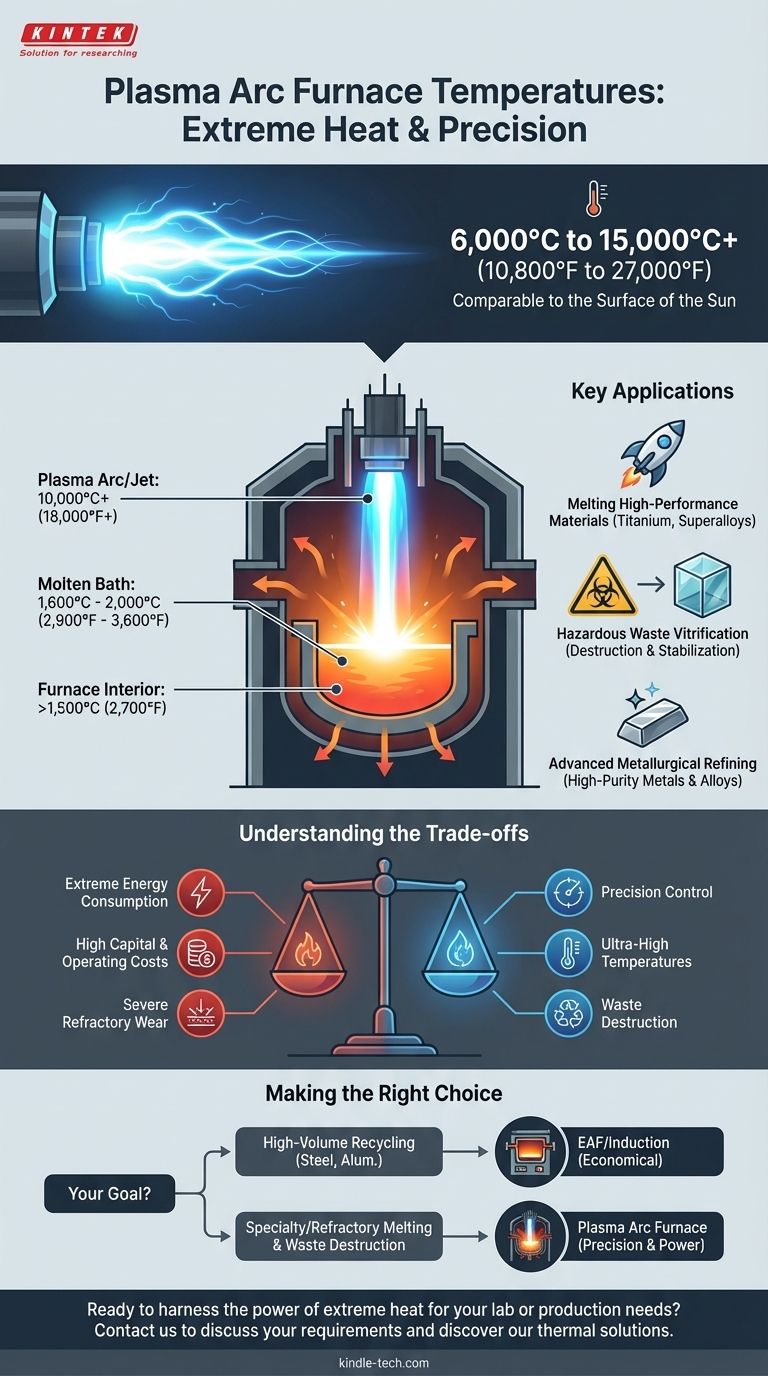その核心において、プラズマアーク炉は従来の加熱方法を凌駕する温度で作動し、プラズマジェット自体が6,000°Cから15,000°C超(10,800°Fから27,000°F)に達します。これは太陽の表面温度に匹敵します。ただし、この極度の熱はアークに高度に局在しており、溶融した材料や炉の内部は異なる、より低い温度で動作します。
プラズマアーク炉を特徴づけるのは、単に極度の熱であるだけでなく、その熱を精密かつ制御された方法で供給できる能力です。これにより、単なる溶解装置から、先進的な材料処理および廃棄物処理のための洗練されたツールへと変貌します。
プラズマアークがいかにして極度の温度を達成するか
炉を理解するためには、まずプラズマを理解する必要があります。プラズマは物質の第4の状態であり、ガスが電子が原子から剥ぎ取られるほどエネルギーを与えられ、イオン化された導電性のガスを形成するときに生成されます。
プラズマ生成の原理
プラズマトーチは、アルゴン、窒素、あるいは空気などのガスの流れの中で、雷のように高電圧の電弧を発生させます。この強烈な電気エネルギーがガスを過熱し、イオン化させ、集束されたプラズマジェットを生成します。このジェットの安定性と温度は、電源とガス流量によって精密に制御されます。
移送アークと非移送アーク
主に2つの構成があります。移送アークは、トーチの電極と加熱される導電性材料(「チャージ」)との間に形成されます。この方法は、エネルギーをターゲットに直接供給する効率が非常に高いため、金属の溶解に理想的です。
非移送アークは、トーチ内部に完全に閉じ込められます。その後、プラズマは超高温ガスの高速ジェットとして噴射されます。これは、熱スプレーや電気伝導性がない廃棄物の処理など、さまざまな用途によく使用されます。
炉内の熱の構造
プラズマ炉には単一の温度があるわけではないことを理解することが重要です。そこには明確な熱ゾーンがあります。
- プラズマアーク/ジェット: アークの中心が最も高温の点で、10,000°C以上に達します。ここはイオン化の物理現象が発生する場所です。
- 溶融プール: 溶解されている材料(鋼やチタンなど)は、通常、液体状態を維持するために必要な温度、多くの場合1,600°Cから2,000°Cの間にあります。プラズマアークは、この温度を維持するための熱源として機能します。
- 炉内部(フリーボード): 溶融プールの上部の空間はアークよりも著しく低温ですが、それでも非常に高温であり、多くの場合1,500°Cをはるかに超える温度を保持しています。

なぜこのレベルの熱が重要なのか:主要な用途
プラズマアーク加熱の独自の能力は、電気アーク炉(EAF)や誘導炉などの従来の炉では困難または不可能なプロセスを可能にします。
高性能材料の溶解
主な利点は、融点が非常に高い金属やセラミックスを溶解できることです。これには、航空宇宙、防衛、医療用途に不可欠なチタン、ニッケル基超合金、タングステンやモリブデンなどの耐火金属が含まれます。
有害廃棄物のガラス化
プラズマ加熱は、有害物質を破壊するための決定的なソリューションです。強烈な熱は、複雑な有機化合物、アスベスト、医療廃棄物をその構成元素に分解します。これらの元素は冷却され、スラグと呼ばれる安定した、浸出しないガラス状の固体に融合されます。
先進的な冶金精製
極度の熱と制御された雰囲気の組み合わせにより、優れた冶金精製が可能になります。これにより、不純物を効率的に除去し、組成が精密に制御された高純度の金属および合金を製造できます。
トレードオフの理解
プラズマ技術の優れた能力には、重大な運用の考慮事項が伴います。それはすべての作業に適したツールではありません。
極度のエネルギー消費
安定したプラズマアークを生成し維持するには、莫大な量の電気エネルギーが必要です。これにより、標準的な鋼のリサイクルに使用される従来の電気アーク炉と比較して、プロセスはトンあたりのエネルギー消費量とコストが大幅に高くなります。
高い設備投資および運転コスト
プラズマトーチ、その特殊な電源、およびガス供給システムは複雑で高価です。さらに、アルゴンなどのプラズマガスのコストは大きな運用費用となり得ますが、一部のシステムは空気で動作するように設計されています。
深刻な耐火物摩耗
プラズマアークの強烈で集束された熱は、炉の内張りを構成する耐火材料に対して非常に破壊的です。「耐火物摩耗」は主要な運用の課題であり、他のタイプの炉と比較してメンテナンスコストとダウンタイムの増加につながります。
あなたの目標に合った正しい選択をする
適切な熱技術の選択は、特定の材料と処理目標に完全に依存します。
- 鋼やアルミニウムなどの標準的な金属の大容量リサイクルに重点を置いている場合: 従来の電気アーク炉(EAF)または誘導炉の方が、ほとんどの場合、より経済的で効率的な選択肢となります。
- 特殊合金、チタン、または耐火金属の溶解に重点を置いている場合: プラズマアーク炉は、他の技術では匹敵できない必要な温度、制御、およびクリーンな環境を提供します。
- 有害廃棄物の完全破壊、または超高純度材料の製造に重点を置いている場合: プラズマアーク炉は決定的なツールであり、比類のないレベルの熱分解と精製を提供します。
最終的に、プラズマアーク炉は、単なる強力な加熱装置としてではなく、物質をその最も基本的なレベルで操作するための精密機器として捉えるのが最善です。
要約表:
| 特徴 | 温度範囲 | 主な用途 |
|---|---|---|
| プラズマアーク/ジェット | 10,000°C以上 (18,000°F以上) | イオン化、極度の加熱 |
| 溶融材料 | 1,600°C - 2,000°C (2,900°F - 3,600°F) | 金属、合金の溶解 |
| 炉内部 | 1,500°C超 (2,700°F超) | 制御雰囲気下での処理 |
あなたの研究室または生産ニーズのために極度の熱の力を活用する準備はできていますか?
KINTEKでは、高性能合金、耐火金属の精密溶解、および有害廃棄物のガラス化を目的としたプラズマアーク炉を含む、先進的な熱ソリューションを専門としています。当社の専門知識により、優れた材料処理と制御のために適切な機器を入手できます。
お客様の具体的な要件についてご相談いただき、当社のラボ機器がお客様の研究または生産能力をどのように向上させることができるかをご確認いただくために、今すぐお問い合わせください。 今すぐ専門家にご連絡ください!
ビジュアルガイド




















